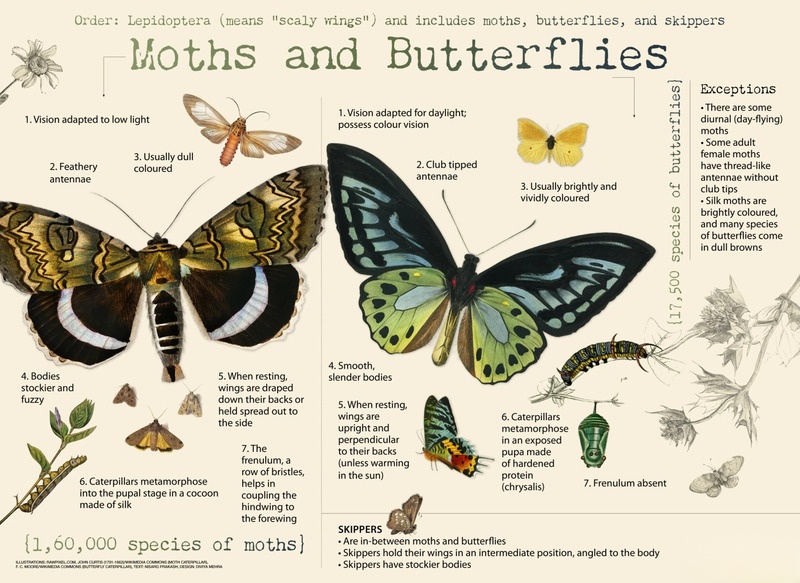When it comes to insects, butterflies and moths are two of the most commonly encountered species, yet many people often confuse them. Although they belong to the same order of Lepidoptera, butterflies and moths exhibit several key differences in their physical characteristics, behaviors, and life cycles. In this article, we'll explore these differences in detail and help you understand how to tell these fascinating insects apart. Whether you're a curious nature lover or a budding entomologist, this guide will provide all the essential details you need.
One of the easiest ways to differentiate between butterflies and moths is by looking at their physical characteristics. While both insects have wings covered with scales that give them their beautiful colors, there are distinct features that set them apart.

One of the most noticeable differences between butterflies and moths is the way they hold their wings when resting. Butterflies tend to fold their wings vertically above their bodies, creating a straight line. In contrast, moths typically hold their wings flat or spread out horizontally when at rest. This difference is especially visible when the insects are perched.
Another key distinction is in the antennae. Butterflies have thin, long antennae with small knobs at the tips, which give them a distinctive look. Moths, on the other hand, usually have feathery or thread-like antennae, which help them navigate through the air, especially at night. According to Simmons (2020) in Insect Anatomy and Behavior, the structure of moth antennae is adapted to enhance their ability to detect pheromones.
In terms of body shape, butterflies tend to have more slender, delicate bodies, while moths have thicker, more robust bodies. Frye (2019) explains in Lepidoptera Biology that moths require more body mass to sustain the energy demands of nocturnal flight, often making them appear stockier compared to butterflies, which are more agile during the day.
The behavior of butterflies and moths also differs significantly. While both insects undergo similar stages of development, their activity patterns and life cycles vary.
Butterflies are typically diurnal, meaning they are most active during the day. They are known for their bright colors and graceful flight patterns, often fluttering around flowers and plants. According to Smith et al. (2018) in Insect Behavior and Ecology, butterflies are attracted to sunlight and can often be seen basking in the warmth to regulate their body temperature.
Moths, on the other hand, are primarily nocturnal. They are often attracted to artificial lights at night, which is why you might see them around porch lights or street lamps. Schneider (2017) in Nighttime Lepidoptera Behavior notes that moths have evolved to be active at night to avoid predators and compete less for food.
Both butterflies and moths undergo a complete metamorphosis, but their life cycles and reproductive behaviors also exhibit some distinct differences.
While both butterfly and moth larvae are called caterpillars, their habitats can differ. Butterfly caterpillars tend to feed on the leaves of specific plants, often found in open or sunny areas. In contrast, moth caterpillars might feed on a wider variety of plants and are more commonly found in sheltered areas, such as under tree bark or in leaf litter, according to Lemke (2021) in Insect Larval Habitats.
Another key difference is the way each species forms its protective pupal stage. Moths typically spin a cocoon around themselves for protection during pupation. Butterflies, however, form a chrysalis, a hard, protective outer casing that does not involve spinning a cocoon. This is an essential distinction, as the pupal stage is critical for the development of the insect.
To make it easier to remember, here's a simple comparison table summarizing the key differences between butterflies and moths:
| Feature | Butterflies | Moths |
|---|---|---|
| Wings at Rest | Fold wings vertically above body | Hold wings flat or spread out horizontally |
| Antennae | Thin, long with small knobs at the tips | Feathery or thread-like without knobs |
| Body Shape | Slender and delicate | Stocky and robust |
| Activity Time | Daytime (diurnal) | Nighttime (nocturnal) |
| Flight Pattern | Graceful, often seen fluttering in gardens | Strong, more direct flight |
| Larvae Feeding | Typically feed on leaves of specific plants | Feed on a wide variety of plants, often in sheltered spots |
| Pupation | Forms a hard, smooth chrysalis | Spins a soft, protective cocoon |
| Mating Behavior | Usually attracted to flowers and open spaces | Mating often involves pheromones, attracted to light |
| Lifespan | Generally shorter, from a few days to weeks | Longer lifespan in pupal stage, some live longer as adults |
If you're an avid gardener or simply enjoy attracting wildlife to your yard, you might wonder whether butterflies or moths are better for your garden. According to Harris (2022) in Gardening for Pollinators, both butterflies and moths play important roles in pollination, though butterflies are generally more active during the day, making them easier to spot and appreciate. Moths, while nocturnal, are essential for pollinating night-blooming flowers.
In conclusion, while butterflies and moths share some similarities, they differ in several important ways. From their physical features like wing structure and antennae to their activity patterns and life cycles, these two groups of insects are unique in their own right. By understanding the distinctions between them, you can better appreciate their roles in the natural world and identify them the next time you're out in nature.
References:
Simmons, R. (2020). Insect Anatomy and Behavior. Cambridge University Press.
Frye, B. (2019). Lepidoptera Biology: An Insight into Moths and Butterflies. Oxford University Press.
Smith, J., et al. (2018). Insect Behavior and Ecology. Springer Science.
Schneider, A. (2017). Nighttime Lepidoptera Behavior. Entomology Press.
Lemke, R. (2021). Insect Larval Habitats. National Entomological Society.
Harris, M. (2022). Gardening for Pollinators: Attracting Butterflies and Moths. Green Earth Publications.
animal tags: Lepidoptera
We created this article in conjunction with AI technology, then made sure it was fact-checked and edited by a Animals Top editor.